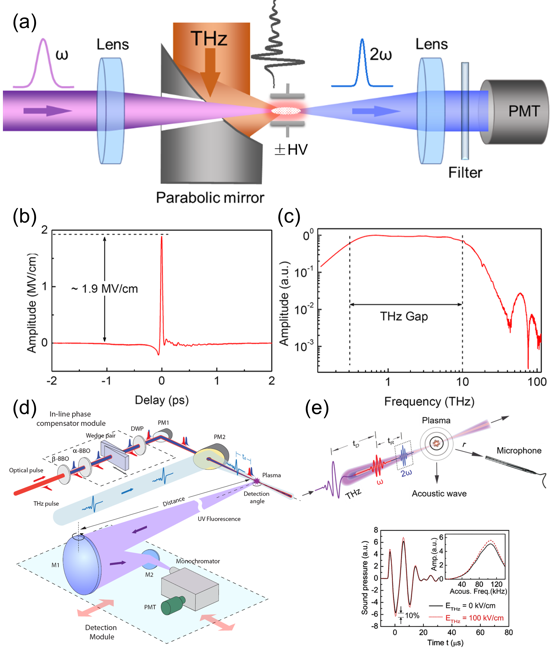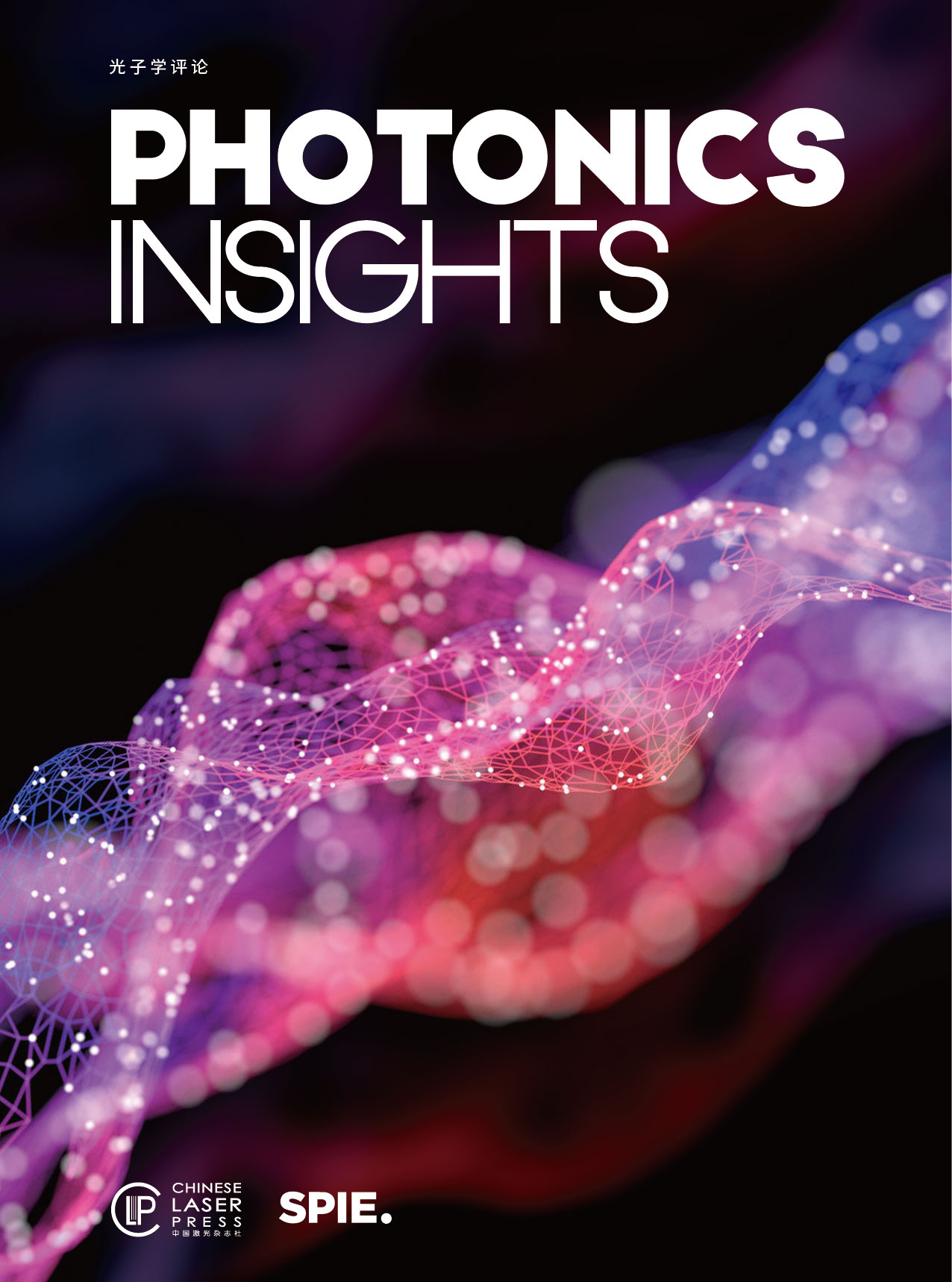In past decades, substantial advances in terahertz (THz) science and technology have opened up a wide range of opportunities for research in physics, chemistry, material science, biology, and medicine etc. Potential applications of THz technology in biomedical analysis, linear and nonlinear spectroscopy, chemical/biological sensing, explosives detection, tomographic imaging, and nondestructive testing have thrust THz research from relative obscurity to new heights. In practice, some of the applications set higher requirements on both THz wave sources and detectors, in terms of THz pulse energy or peak electric field, bandwidth, polarization, and signal-to-noise ratio etc. Therefore, various THz sources and detectors with high peak electric field and ultra-broad bandwidth are highly desired. The requirement on THz sources and detectors with high peak field and ultra-broad bandwidth, in turn, propels the development of THz wave photonics based on gas-phase and liquid-phase plasmas.
Recently, a team of scientists led by Prof. Jianming Dai in Center for Terahertz Waves and School of Precision Instrument & Opto-Electronics Engineering at Tianjin University was invited by Co-Editors-in-Chief to contribute a comprehensive review paper entitled “Plasma-Based Terahertz Wave Photonics in Gas and Liquid Phases”, which was published in Photonics Insights. (Yuxuan Chen, Yuhang He, Liyuan Liu, Zhen Tian, Xi-Cheng Zhang, Jianming Dai. Plasma-based terahertz wave photonics in gas and liquid phases[J]. Photonics Insights, 2023, 2(3): R06).
In this review article, a systematical review of plasma-based THz wave photonics in gas and liquid phases is presented. The focus is on the theoretical and experimental research on utilizing gas and liquid plasma as THz wave emitters and detectors to achieve ultra-broadband, high electric field, coherent THz wave generation, detection, and all-optical coherent manipulation.
Advanced THz sources based on nonlinear optical crystals, such as Lithium niobate, organic, and GaSe crystals, have been proposed to generate high energy broadband THz pulses. Besides, conventional THz detectors based on electro-optical crystals, such as GaP crystal, can achieve a detection bandwidth up to 8 THz through electro-optic sampling. However, the performances of these crystal-based THz sources and detectors are limited by the phonon absorption, optical damage threshold, and phase matching condition in the crystals. Plasma-based THz sources and detectors, especially gas plasma-based THz source and detector, exhibit advantages over other THz sources and detectors.
As shown in Table 1, gas plasma-based THz sources have the advantages of high peak electric field and ultra-broad spectral bandwidth. Furthermore, by utilizing two-color laser-induced plasma, all-optical coherent manipulation of THz wave amplitude and polarization can be achieved by changing the relative phase and polarization of the two-color laser fields. Benefiting from the absence of phonon absorption bands in the THz frequency range, coherent detection of THz waves based on air plasma can obtain super smooth and defect-free THz spectra with ultra-broad bandwidth limited only by the probe laser pulse duration.

Table 1 Highest experimental records for advanced THz sources
In recent years, liquids such as liquid water, liquid nitrogen, ethanol, and acetone have been proven to be prospective broadband THz sources and sensors, owing to their higher molecular density and lower ionization threshold in comparison with those in gases. Further improvements of THz sources and sensors based on liquid plasmas can be expected in terms of peak electric field, conversion efficiency, coherent polarization control, and THz detection sensitivity.
There are mainly three methods for generating THz waves using gas plasma:
(1) as shown in Figure 1(a), a single-color laser pulse creates plasma directly in gas after being focused by a lens. Driven by the ponderomotive force, electrons in the plasma oscillates under single-color laser excitation, emitting THz waves. The THz waveform is shown by the magenta curve in Figure 1(d).
(2) as Figure 1(b) shows, a fundamental laser pulse (ω) is focused through a BBO crystal to generate a second harmonic pulse (2ω). The ω and 2ω laser pulses synthesize and form a plasma, resulting in THz wave emission with a waveform represented by the blue curve in Figure 1(d).
(3) as shown in Figure 1(c), an interferometric phase compensator (PC) based on a two-color Mach–Zehnder interferometer (not displayed in the figure) is used to combine the ω and 2ω beams with a dichroic mirror. Such a PC can control the polarization and phase of each optical beam individually for coherent control of the THz emission. Under moderate experimental conditions, the peak electric field of THz waves generated by two-color laser-induced gas plasma is approximately 2 to 3 orders of magnitude higher than that of single-color excitation scheme.
Moreover, the amplitude and polarization of the generated THz waves can be coherently controlled by the relative phase and polarization of ω and 2ω laser pulses. Therefore, two-color laser excitation scheme is commonly used for generating THz waves with high peak electric fields and tunable polarization.

Figure 1 (a)-(c) Schematic diagrams of THz generation from gas plasma. (d) Typical THz waveforms generated by single- and two-color laser fields.
In order to achieve the stable control of the amplitude and polarization of THz waves, an in-line phase compensator is used to change the relative phase and polarization of the ω and 2ω laser pulses, as shown in Figure 2(a). By changing the insertion of the optical wedge, the relative phase between the ω and 2ω laser pulses can be coherently modulated, resulting in the periodic modulation of the THz power as shown in Figure 2(b).
Furthermore, the dual-wavelength waveplate in the in-line phase compensator can change the polarization combination of the ω and 2ω laser pulses. Combined with the modulation of the relative phase, coherent polarization control of the generated THz wave can be achieved, as shown in Figure 2(c)-(d). Polarization control of THz waves is of great significance for applications that require broadband THz waves with tunable polarization.

Figure 2 Coherent control of THz wave generated in two-color laser-induced air plasma. (a) Schematic diagram of the setup; (b) Coherent control of THz power by the relative phase delay between the ω and 2ω laser pulses; (c)-(d) Examples of coherent control of THz wave polarization: THz intensity versus THz polarizer rotation angle and the relative phase between the ω and 2ω pulses with (c) left-handed circularly polarized ω pulse and elliptically polarized 2ω pulse (with an ellipticity of about 1/11 in terms of optical intensity), and (d) with both ω and 2ω beams right-handed circularly polarized.
Three methods have been proposed for coherent detection of THz waves using gas plasma: THz air-breakdown (or air-biased) coherent detection (THz-ABCD), THz wave detection utilizing THz-radiation-enhanced emission of fluorescence (THz-REEF), and THz-enhanced acoustics (TEA), as shown in Figures 3(a), (d), and (e) respectively. Benefiting from the absence of phonon absorption in the THz frequency range, coherent THz detection using air plasma can achieve smooth and defect-free ultra-broadband THz spectra.
Figures 3(b) and (c) show the waveform and corresponding Fourier transform spectrum of THz wave from two-color laser-induced air plasma obtained by THz-ABCD. The peak electric field of the THz wave is about 1.9 MV/cm. As shown in Figure 3(c), when the pulse duration of the probe laser pulse is 28 fs, the THz spectrum obtained by THz-ABCD has a frequency coverage of about 100 THz with a plateau covering the entire THz gap and beyond, which is of great significance for THz spectroscopy.
.

Figure 3 (a) Schematic illustration of the experimental setup for THz-ABCD. (b) THz waveform obtained by THz-ABCD. (c) Fourier transform spectrum of the THz waveform obtained by THz-ABCD. (d) Schematic illustration of the THz wave remote sensing technique via THz-REEF. (e) Upper panel: Schematic illustration of the experimental setup used for the TEA. Lower panel: acoustic signals detected by a microphone.
In addition, as shown in Figure 3(d), the utilization of THz-REEF can also achieve coherent detection of THz waves. Since the fluorescence generated by the plasma can propagate over a long distance in air, THz-REEF can be used for remote sensing of THz waves. Similarly, as shown in Figure 3(e), using acoustic detector, TEA technology can be used to achieve coherent detection of THz waves, providing an additional approach for coherent detection of THz waves.
Thanks to the high molecule density and low ionization threshold of liquids, research on THz wave generation and coherent detection based on liquid plasma has gradually emerged in recent years. As shown in Figure 4(a), THz wave can be emitted from plasma generated in liquid water when a single-color laser beam is incident obliquely into the water film. Additionally, since the ionization processes in gas and liquid are different, the optimal laser pulse duration for generating liquid plasma is on the sub-picosecond scale.
Similar to that in air, THz field-induced second harmonic generation (TFISH) in liquids can also be used for coherent detection of THz waves, as shown in Figure 4(b). Due to the lower ionization threshold of liquids, the energy of probe laser pulse required for coherent detection of THz waves based on plasma in liquids is lower than that in air.
Since research on THz sources and coherent detection based on liquid plasma is still in its early stages, currently it does not have significant advantages over air plasma in various aspects. With further exploration and optimization of THz sources and detectors based on liquid plasma, improvements in terms of peak electric field, emission efficiency, coherent polarization control, as well as THz detection sensitivity can be expected in the future.

Figure 4 (a) A typical experimental setup used to generate and detect THz waves from water films. (b) Schematic of the experimental setup for coherent detection of broadband THz waves with laser-induced plasma in liquid water.
In addition to further optimizing and improving the performances of THz sources and detectors based on gas and liquid plasma, one of the important future progresses in THz gas and liquid photonics is applying these plasma-based THz sources and coherent detection methods to linear and nonlinear THz spectroscopy, as well as biochemical composition analysis.
Thanks to the high peak electric field and ultra-broad spectral bandwidth of air plasma-based THz sources and detectors, recent studies have applied them to investigate the linear and nonlinear characteristics of novel materials (such as graphene) in the THz range. As a result, THz gas and liquid photonics will become an important foundation and efficient research tool in many cutting-edge research fields.


